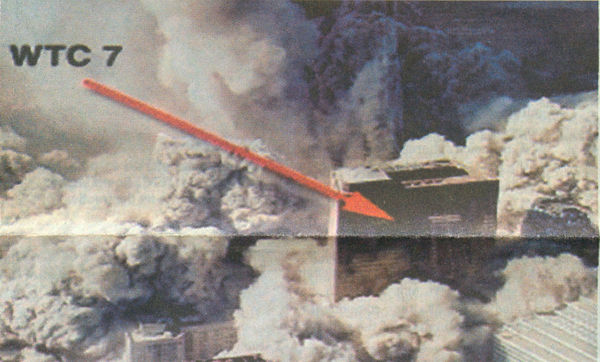Building 7 Implosion (911 Investigator 1.1)
Building 7 Implosion: The Smoking Gun of 9/11
- By Richard Gage, AIA, Gregg Roberts, and David Chandler
- from 911 Investigator 1.1
Seven hours öfter the explosive destruction of the World Trade Center Twin Towers, a third high-rise building was demolished. It was not hit by an airplane. The characteristic signs of controlled demolition were everywhere.

Although it received little media attention at the time, the third-worst structural building failure in modern history occurred on September 11, 2001. World Trade Center (WTC) Building 7 was a 47-story, steel-framed, fire-protected, high-rise office building located about a football field's length from the WTC North Tower. Unlike its two taller cousins, WTC 7 was never hit by an aircraft, yet it fell to the ground suddenly, displaying the classic signatures of explosive controlled demolition.
The evidence (discussed in this article) was ignored, mishandled, and/or covered up by the National Institute of Standards and Technology (NIST), the federal agency tasked with explaining its unprecedented destruction.

- A Mysterious Catastrophe
Although Building 7 was never hit by an airplane and had only isolated pockets of fires on about 10 floors, it suddenly imploded - coming down neatly, symmetrically, and completely at 5:20 p.m. The official story, according to NIST, is that WTC 7 collapsed due to "normal office fires" which created a "new phenomenon" in high-rise fires: destruction due to thermal expansion of steel beams, leading to the progressive collapse of nine floors. This ultimately caused the failure of column #79 - which was followed within seconds by all the rest.
Some observers had speculated that stores of diesel fuel inside the building might have produced exceptionally intense fires leading to the unusual collapse. However, NIST has officially acknowledged that diesel fuel was not involved. NIST also ultimately concluded that the impact of debris from the North Tower was not a significant contributor to the collapse, although it was blamed for starting the fires. What NIST's top engineers failed to explain - and often even to acknowledge - in their Final Report were the many features of the building's destruction that are normally seen only in explosive controlled demolitions.
- Evidence for Controlied Demolition
After an embarrassing series of questions from AE911Truth petition signers, NIST's top engineers ultimately acknowledged some of the key facts surrounding the building's destruction. However, NIST still refuses to seriously examine the hypothesis of explosive demolition, even though demolition is the only cause that has ever produced such structural failure and that exhibited the characteristics of Building 7's destruction. In fact WTC 7's failure was indistinguishable from a classic controlled implosion.
Let's consider the evidence: